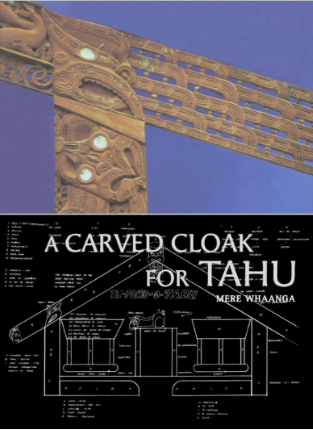
A Carved Cloak for Tahu – Mere Whaanga (2004)

A Carved Cloak for Tahu gives a comprehensive history concerning the descendants of Ngāti Rongomaiwahine and Ngāti Kahungunu, particularly focusing on Ngai Tahu Matawhaiti.
Publication details
Whaanga, M. A Carved Cloak for Tahu. Auckland: Auckland University Press, 2004.
About the book
In A Carved cloak for Tahu, Mere Whaanga (Ngāti Rongomaiwahine, Ngāti Kahungungu) provides a model for recording Māori history that draws on a long- established tradition within Māoridom. Traditionally, orators used the whakairo, or carvings, within the meeting house as a mnemonic to assist in retelling hapū narrative and history. Whaanga uses the carvings of the meeting house Te Poho o Tahu as the framework for her book. This is an example of old traditions informing a new approach to recording hapū and iwi history.
Starting with the building of Te Poho o Potiki, the central wharenui at Iwitea of Ngāi Tahu Matawhāiti, a hapū of Ngāti Kahungunu, A Carved Cloak for Tahu explores its taonga, the iwi and hapū identities represented in its waiata, stories and carvings, its colonial history including experience with the Native Land Court and the religions to which the people have adhered, particularly Te Kohititanga Marama. Whaanga also investigates issues of cultural identity and contemporary pressures, giving an overview of the industries in which hapū labour has worked (flax mills, farming, freezing works) and examining the exercise of hapū affiliations. She describes the strengthening of cultural identity that occurs when people gather to discuss concerns such as environmental and resource management and the impact of new industry on their area (e.g. proposals to drill for gas). Though focused on a small area in northern Hawke's Bay, this publication has relevance for many other iwi.
Finalist, Montana New Zealand Book Award, History Category, 2005.
Further information
This publication is part of the series Te Takarangi: Celebrating Māori publications - a sample list of 150 non-fiction books produced by a partnership between Royal Society Te Apārangi and Ngā Pae o te Māramatanga.
